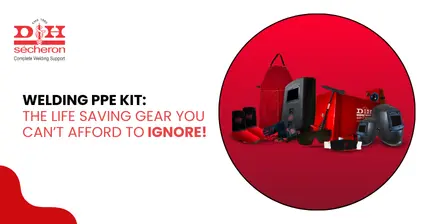Exploring the Different Types of Stainless Steel Electrodes
Stainless steel, celebrated for its resistance to corrosion, durability, and aesthetic appeal, is a staple in diverse welding applications. The selection of the appropriate stainless steel electrode or welding electrode plays a pivotal role in the welding process. Let's get a better understanding of stainless steel electrodes so that you can optimise your welds.
Stainless Steel Varieties:
Stainless steel can be broadly categorized into four key types, each suited for specific applications. These categories encompass:
1. Austenitic Stainless Steel: Renowned for its superb corrosion resistance, this type includes popular grades like 304 and 316. Industries like food processing, pharmaceuticals, and architectural construction widely use these grades.
2. Ferritic Stainless Steel: Featuring magnetic properties, this type is known for its resistance to corrosion and oxidation. It is prevalent in automotive applications, particularly in the manufacturing of exhaust systems.
3. Martensitic Stainless Steel: With exceptional hardness and strength, this variety is a preferred choice in applications that demand wear resistance, such as cutlery production and turbine blades.
4. Duplex Stainless Steel: Combining the strengths of both austenitic and ferritic stainless steel, this type provides a unique blend of high strength and corrosion resistance. It is often utilized in demanding industries like chemical processing and oil and gas.
Different Types of Stainless Steel Electrodes:
1. E308/E308L: Among the most commonly used stainless steel electrodes, E308 electrodes provide excellent resistance to corrosion whereas E308L are designed for welding 18% chromium, 8% nickel stainless steels (often referred to as 18-8 steels). E308L electrodes have a lower carbon content, making them ideal for welding applications where carbide precipitation and corrosion resistance are essential.
2. E309/E309L: Specifically formulated for welding dissimilar metals, these electrodes are designed to weld stainless steel to carbon steel or other low-alloy steels. E309 electrodes offer superior strength and resistance to cracking in high-temperature environments, making them ideal for applications in the petrochemical industry and in boiler and pressure vessel fabrication.
3. E316/E316L: Tailored for welding 18% chromium, 12% nickel, 2% molybdenum stainless steels, a.k.a. 316 stainless steel, these electrodes are highly corrosion-resistant and are used in applications where resistance to pitting and crevice corrosion is critical. E316L electrodes, with lower carbon content, are preferred for applications that require maximum resistance to intergranular corrosion.
4. E310: Designed for welding heat-resistant and high-temperature alloys, these electrodes can withstand temperatures up to 2,100°F (1,150°C) while maintaining their strength and integrity, making them ideal for furnace and heating parts.
5. E347/E347L: Designed for welding stabilized stainless steels, such as 321 stainless steel, these electrodes provide resistance to carbide precipitation and intergranular corrosion, making them a top choice in the aerospace and automotive industries.
Conclusion:
As we've delved into the world of stainless steel electrodes and their applications across various industries, the importance of choosing the right welding solution becomes abundantly clear. D&H Sécheron, a name synonymous with excellence in the welding industry, offers a comprehensive range of stainless steel electrodes that cater to the diverse needs of welders in different sectors. Their commitment to quality and innovation has made them a trusted choice for professionals around the globe.
11 May 2025 | Welding
An In-Depth Exploration of Low-Alloy Steel: Your Comprehensive Guide
11 May 2025 | Welding
Nagpur - Bori - Tuljapur Road MSH-3 in Yavatmal District (Maharashtra)
11 May 2025 | Welding
Guidelines to Understand Gas Welding: Applications, Advantages & Disadvantages
11 May 2025 | Welding
3 Tips for Finding the Best Mild Steel Electrode for Your Application
11 May 2025 | Welding
How to Select the Right Welding Filler Wires for Stainless Steel Welding?
11 May 2025 | Welding
Building the Narendra Modi Stadium with Norma V and Autotherme-1 Electrodes
11 May 2025 | Welding
Low Alloy Steel Welding in a (PEB) Pre Engineered Building Structure
11 May 2025 | Welding
Welding Rods: Different Types and Tips for Properly Storing and Handling
11 May 2025 | Welding
Tips for Flawless Welds with Stainless Steel Electrodes: Pros and Cons
11 May 2025 | Welding
Exploring Applications and Benefits of Stainless Steel Welding Electrodes
11 May 2025 | Welding
Welding Basics: Joining Metals with Heat and Pressure - A Beginners Guide
11 May 2025 | Welding
Distinguishing Low-Alloy Steel from High-Alloy Steel: Understanding the Variations
11 May 2025 | Welding
Hard Facing Wire - Understanding the Process and Achieving Optimal Result
11 May 2025 | Welding
Exploring the Advantages of Stainless Steel Electrodes in Welding Applications
11 May 2025 | Welding
Weathering Steel vs. Traditional Steel: A Comparative Analysis of Performance
11 May 2025 | Welding
Choosing the Right Welding Rod: Why 6013 Electrodes Might Be Your Ideal Option
11 May 2025 | Welding
Why 7018 Electrodes Are Preferred for High-Strength Welds in Pipeline Construction
11 May 2025 | Welding
Filler Wire vs. Stainless Steel Filler Wire: Understanding the Key Differences
11 May 2025 | Welding
Exploring the Impact of Filler Material on Welding Quality and Durability
11 May 2025 | Welding
Choosing the Right Cast Iron Electrode for Different Welding Projects
11 May 2025 | Welding
Top Advantages of Cast Iron Electrodes for Industrial Welding Applications
11 May 2025 | Welding
Key Benefits and Challenges of Using TIG Welding in Industrial Projects
11 May 2025 | Welding
5 Reasons Why 7018 Electrode is the Gold Standard for Welding Professionals
11 May 2025 | Welding
Top 5 Advantages of Flux Cored Arc Welding for Heavy-Duty Applications.png)
11 May 2025 | Welding
Lotherme-601: A Game-Changer for Restoring Shoulder Pins in Heavy Machinery
11 May 2025 | Welding
How D&H Sécheron Helped Repair a Rotary Kiln’s Cooler Section with LoTherme 352
11 May 2025 | Welding
Piston Repair for Mining Industry: Cost-Effective Solutions with LoTherme 468.webp)






.jpg)








































.jpg)
.jpg)

.jpg)

.jpg)





.jpg)
.jpg)
.jpg)



.webp)
.jpg)
.jpg)
.webp)
.jpg)





















.png)



.webp)

.webp)
.webp)



